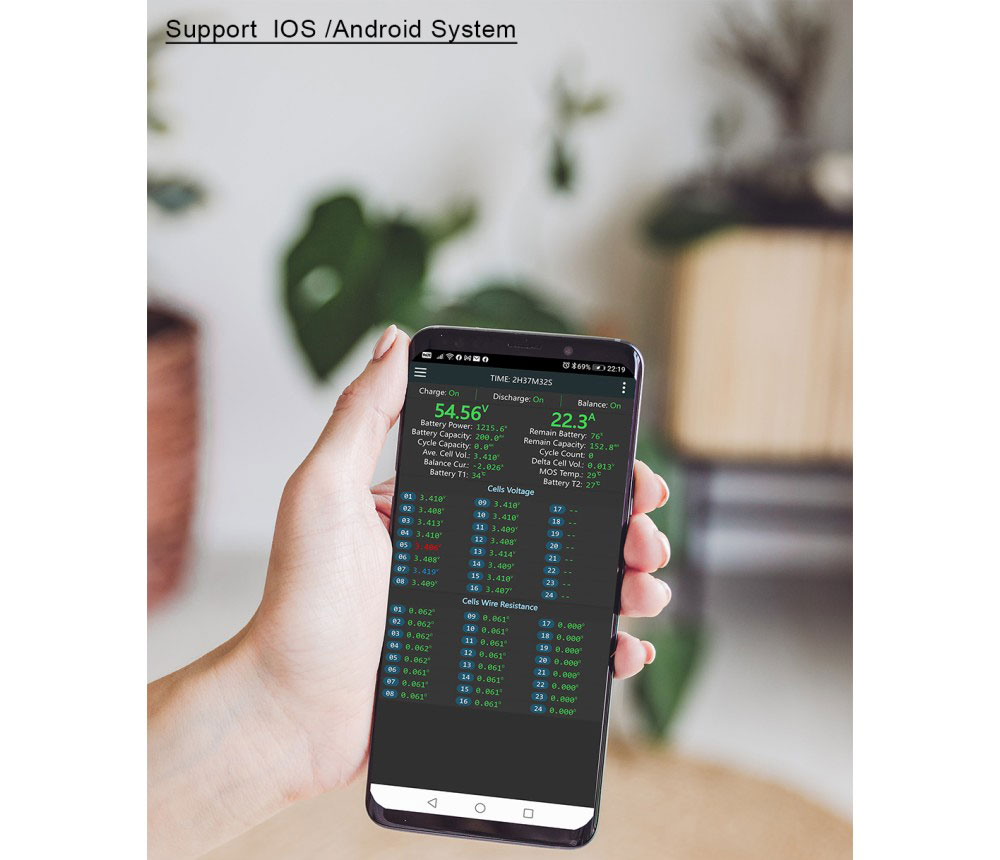The LiFePO4 Battery BMS (Battery Management System) is the brain behind lithium iron phosphate battery packs, ensuring safety, efficiency, and longevity. Whether in electric vehicles (EVs), energy storage systems, or portable devices, a Smart BMS is critical for optimizing BMS Battery performance. In 2025, with advancements in renewable energy, understanding BMS parameters is more important than ever. This article breaks down 25 key technical parameters of a LiFePO4 Battery BMS in a clear, beginner-friendly way while keeping it professional and packed with industry terms. Curious about available options? Check out LiFePO4 Battery BMS models for cutting-edge solutions.
1. Cell Voltage Monitoring
What is it? A LiFePO4 Battery BMS tracks the voltage of each cell to prevent overcharging or deep discharging, acting like a voltage watchdog.
Why it matters: LiFePO4 cells typically operate between 2.5V and 3.65V. Exceeding these limits risks thermal runaway or cell damage.
Terms:
- Overvoltage Protection (OVP): Cuts off charging when voltage is too high.
- Undervoltage Protection (UVP): Halts discharge when voltage drops too low.
2. Current Monitoring
What is it? The BMS monitors charging and discharging currents to avoid overloading the BMS Battery.
Example: In an EV, currents may spike to 100A during acceleration. The BMS ensures this stays within safe limits.
Terms:
- Overcurrent Protection (OCP): Stops excessive current flow.
- Short Circuit Protection (SCP): Instantly cuts off during a short circuit.
3. Temperature Monitoring
What is it? A Smart BMS uses sensors (NTC/PTC) to monitor battery and ambient temperatures, preventing overheating or freezing.
Why it matters: LiFePO4 batteries lose performance below -20°C or above 60°C.
Terms:
- Over-Temperature Protection (OTP): Pauses operation if too hot.
- Under-Temperature Protection (UTP): Limits charging in cold conditions.
4. State of Charge (SOC)
What is it? SOC estimates the remaining battery capacity, like a smartphone’s battery percentage.
How it’s calculated: Uses Coulomb counting (tracking charge flow) or open-circuit voltage (OCV) methods.
Example: An SOC of 50% means half the BMS Battery capacity is available.
5. State of Health (SOH)
What is it? SOH measures battery aging, often based on capacity fade or internal resistance increase.
Why it matters: An SOH of 80% indicates the battery has lost 20% of its original capacity.
Terms:
- Cycle Life: Number of charge-discharge cycles a battery can endure.
- Capacity Fade: Gradual reduction in capacity over time.
6. State of Power (SOP)
What is it? SOP predicts the maximum power a LiFePO4 Battery BMS can deliver under current conditions.
Example: Low SOP in an EV may limit acceleration to protect the battery.
7. Cell Balancing
What is it? The BMS balances cell voltages to ensure uniformity across the battery pack.
Types:
- Passive Balancing: Dissipates excess energy through resistors, simple but wasteful.
- Active Balancing: Transfers charge between cells (e.g., at 2A current) for higher efficiency.
What’s 2A Active Balancing? A 2A current means faster balancing, ideal for large-capacity packs like EVs, reducing voltage differences quickly.
Example: A Smart BMS with 2A active balancing extends battery life in solar storage systems.
8. Charge/Discharge Control
What is it? The BMS manages charging and discharging to optimize efficiency and safety.
Example: LiFePO4 batteries use CC-CV (constant current, constant voltage) charging for fast yet safe charging.
Terms:
- Trickle Charging: Low-current charging for deeply discharged cells.
9. Fault Diagnosis
What is it? The BMS detects issues like cell failure or wiring faults and logs error codes.
Example: An EV dashboard warning may signal a BMS-detected fault.
10. Communication Interface
What is it? A LiFePO4 Battery BMS communicates with external devices via CAN bus, Modbus, UART, or Bluetooth (BLE). Bluetooth is increasingly popular in Smart BMS for smartphone app integration.
Why it matters: Bluetooth allows users to monitor SOC, SOH, or temperatures via an app.
Example: Check your camping power station’s battery status on your phone.

11. Maximum Charge Current
What is it? The BMS limits charging current to protect the BMS Battery.
Example: A home storage system may cap charging at 20A.
12. Maximum Discharge Current
What is it? The BMS sets a discharge current ceiling for safe operation.
Example: Power tools may demand 100A bursts, and the BMS ensures safety.
13. Overvoltage Protection Threshold
What is it? The BMS stops charging if a cell exceeds a set voltage (e.g., 3.65V for LiFePO4).
Why it matters: Prevents overcharging-related safety risks.
14. Undervoltage Protection Threshold
What is it? The BMS halts discharge if a cell drops below a threshold (e.g., 2.5V).
Why it matters: Avoids irreversible damage from over-discharging.
15. Overcurrent Protection Threshold
What is it? The BMS limits current if it exceeds a safe level.
Example: Protects an EV during sudden overloads.
16. Short Circuit Protection Response Time
What is it? The time (often microseconds) it takes the BMS to cut off a short circuit.
Why it matters: Faster response prevents equipment damage.
17. Thermal Management
What is it? The BMS controls battery temperature via air/liquid cooling or heating.
Terms:
- Thermal Runaway: Uncontrolled overheating that could lead to fires.
18. BMS Power Consumption
What is it? The power used by the BMS in active or sleep modes.
Example: In sleep mode, a Smart BMS may consume only microamps.
19. Relay/MOSFET Control
What is it? The BMS uses relays or MOSFETs to control battery connection.
Terms:
- High-Side Driver: Controls the positive terminal.
- Low-Side Driver: Controls the negative terminal.
20. Data Logging
What is it? The BMS records voltage, current, and temperature for analysis.
Example: Logs help diagnose issues in a solar storage system.
21. Firmware Update
What is it? A LiFePO4 Battery BMS supports OTA (over-the-air, including Bluetooth) or wired updates.
Example: Update a Smart BMS via a phone app to improve SOC accuracy.
22. Environmental Adaptability
What is it? The BMS operates in extreme temperatures, humidity, or vibrations.
Terms:
- IP Rating: E.g., IP67 for dust and water resistance.
23. Battery Chemistry Support
What is it? The BMS supports specific battery types like LiFePO4 or NMC.
Why it matters: Different chemistries have unique voltage and charging profiles.
24. Parallel/Series Configuration
What is it? The BMS manages batteries in series or parallel setups.
Example: A solar system may use a 10S4P (10 series, 4 parallel) pack.
25. Certification and Standards
What is it? The BMS complies with safety standards like UL, CE, or IEC 62133.
Terms:
- ISO 26262: Functional safety standard for automotive BMS.
Conclusion
A LiFePO4 Battery BMS is the guardian of battery safety and performance. From voltage monitoring to Bluetooth-enabled Smart BMS features, these 25 parameters ensure your BMS Battery thrives in 2025’s renewable energy landscape. Want to pick the right BMS? Read this beginner’s guide to selecting a BMS to make an informed choice! Got questions? Drop them below!




Leave a Comment